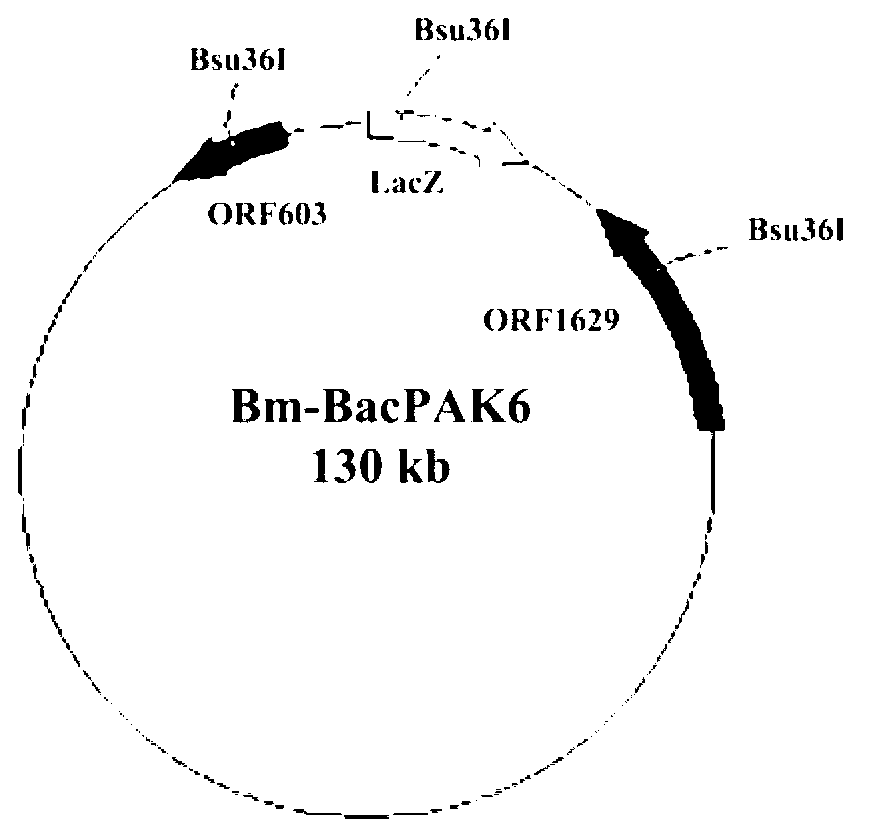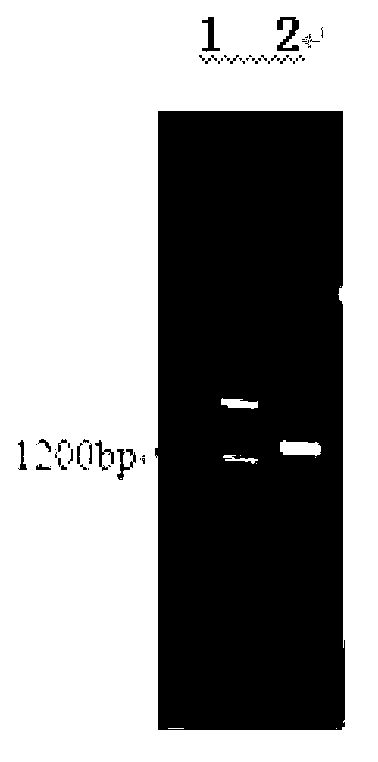Method of expressing rotavirus virus protein 6 (VP6) protein by using silkworm bioreactor
A technology of silkworm baculovirus and group A rotavirus, applied in biochemical equipment and methods, botanical equipment and methods, and the use of vectors to introduce foreign genetic material, etc., can solve the problem of low yield and low yield of plant expression systems, Long cycle and other issues, to achieve the effect of broad market prospects, simple operation process, and low production cost
- Summary
- Abstract
- Description
- Claims
- Application Information
AI Technical Summary
Problems solved by technology
Method used
Image
Examples
experiment example 1
[0083] Experimental example 1, the acquisition of group A rotavirus VP6 gene:
[0084] The full-length VP6 gene of group A rotavirus T114 Chinese local strain is 1356 bp, and the coding sequence is 1194 bp long (as shown in SEQ ID NO: 1), encoding a protein with a molecular mass of 44.9 kD consisting of 397 amino acids. The gene was donated by the Capital Institute of Pediatrics. According to the coding sequence of the obtained VP6 gene, design the 5' forward primer P1 (5'-CGC GGATCC ATGGAGGTTCTGTACTC-3', the underline is the BamHI restriction site) and the 3' reverse primer P2 (5'-CCG GAATTC TCACTTAATCAACATGC-3', the underline is the EcoRI restriction site).
[0085] PCR amplification system:
[0086]
[0087] PCR amplification conditions:
[0088]
[0089] Purify the PCR product to obtain the VP6 gene, the target fragment size is about 1.2kb, see figure 2 .
experiment example 2
[0090] Experimental Example 2, Construction and Identification of Transfer Vector Plasmid
[0091] After the PCR amplification product of the VP6 gene is purified, the purified PCR product is obtained, which is double-digested with restriction endonucleases EcoRI and BamHI, and then inserted through the same digestion (that is, with restriction endonucleases EcoRI and BamHI double-enzyme cut) transfer plasmid pBacPAK 8 (purified carrier plasmid pBacPAK 8), and transformed into Escherichia coli (E. coli) TG1 competent cells for positive colony screening, determined the nucleotide sequence of the recombinant expression plasmid, identified the correct plasmid named pBacPAK 8 -RVVP6.
[0092] recombinant plasmid pBacPAK 8 -RVVP6 was digested by PCR and EcoRI / BamHI double enzymes showed that there was an obvious specific band around 12 00 bp, which was consistent with the expected size, while the negative control did not ( image 3 ), so it can be determined that the target gen...
experiment example 3
[0151] Experimental example 3, construction and screening of BmNPV-RVVP6 of recombinant silkworm baculovirus:
[0152] Extraction of Bombyx mori baculovirus Bm-BacPAK 6 DNA, and digested with Bsu36 I to linearize it to obtain linearized silkworm baculovirus Bm-BacPAK 6 DNA; extract highly pure pBacPAK 8 -RVVP6 plasmid and linearized silkworm baculovirus Bm-BacPAK 6 DNA was co-transfected into silkworm BmN cells.
[0153] details as follows:
[0154] Take A centrifuge tube and add the recombinant transfer vector plasmid pBacPAK 8 - RVVP6 1 μg, linearized viral DNA (i.e., linearized Bombyx mori baculovirus Bm-BacPAK 6 DNA) 5 μg, use serum-free TC-100 medium to make up the total volume to 50 μL; B centrifuge tube plus liposome (FuGENE 6 Transfection Reagent purchased from Roche Company,) 6 μL, use serum-free TC-100 medium Make up the total volume to 50 μL; mix centrifuge tubes A and B evenly, and place at room temperature for 15 min; wash the silkworm BmN cells twice wit...
PUM
 Login to View More
Login to View More Abstract
Description
Claims
Application Information
 Login to View More
Login to View More - R&D Engineer
- R&D Manager
- IP Professional
- Industry Leading Data Capabilities
- Powerful AI technology
- Patent DNA Extraction
Browse by: Latest US Patents, China's latest patents, Technical Efficacy Thesaurus, Application Domain, Technology Topic, Popular Technical Reports.
© 2024 PatSnap. All rights reserved.Legal|Privacy policy|Modern Slavery Act Transparency Statement|Sitemap|About US| Contact US: help@patsnap.com










